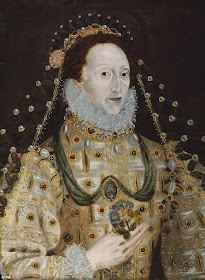Do you love cats and history? Then this post is for
you.
Our history concerns the gentleman in the portrait
with a fine head of hair. He is no lesser person than a Tudor aristocrat, Henry
Wriothesley, the third Earl of Southampton. This dashing looking fellow was
notorious for a number of reasons, not least being that he was Shakespeare’s
patron and rumoured to have romantic attachments to the great bard.
But our tale concerns his political machinations, and
the inspiration behind the portrait. So look closely and what do you see?
A well-dressed nobleman with bows on his cuffs. A
wood-panelled chamber. A black and white cat perched on a window ledge. But
look again. Did you spot behind Wriothesley’s left shoulder the painting of the Tower of London?
Wriothesley did indeed spend time imprisoned in the Tower.
He chose his friends poorly, and fell in with a group of noblemen who in 1601
rebelled against the elderly Queen Elizabeth I.
 |
| Queen Elizabeth I |
The aim of their insurrection was to force the Queen
to name, her cousin’s son, James VI of Scotland, as her heir. They feared if
she did not, there would be civil war when the Queen died. However Elizabeth
believed naming a successor would number her own days – after all she had
ordered the execution of James’ mother, Mary Queen of Scots.
 |
| James VI of Scotland, in younger life |
The rebels were led the Earl of Sussex, Sir Robert
Devereux, and the Earl of Southampton. But their attempts to rouse London’s
inhabitants one Sunday failed miserably. They had fatally underestimated the
lethargy thought prosperity induced. They were captured and Essex executed.
However, Wriothesley was left to think on the folly of
his actions whilst incarcerated in the Tower. His mother and wife pleaded with
Elizabeth for clemency and to not execute him. For her part Elizabeth had lost
her appetite for blood and agreed to let him keep his life but languish in the
Tower of London at her pleasure.
 |
| Wriothesley in 1594 |
And this is where the cat comes in. Apparently, bereft
of company and comfort, Wriothesley was pretty miserable and had an unhappy
time of his imprisonment. Legend has it that Wriothesley missed his favourite
cat, Trixie. In turn, she missed her master and contrived break into the prison
by climbing down the chimney.
“After he
[Wriothesley) had been confined there
[The Tower of London] a small time, he
was surprised by a visit from his favourite cat, which had found its way to the
Tower.”
Thomas Pennant,
1793 “Some Account of London”.
However, a less romantic explanation exists as to how
Trixie came to be there. It was muttered that Wriothesley’s wife brought the
cat along on a visit.
And finally, the portrait is hugely interesting in its
own right. It was painted in a rush shortly after the death of Queen Elizabeth
I in March, 1603. The painting was completed in just six days and nights, and
then rushed to Edinburgh for James to see. It is rich with code and appealed
for the new King of England to set him free.
The code hidden within the picture includes:
·
He is wearing
black, a sign of mourning for the Earl of Essex (and a hero to James).
·
A pane of glass is smashed, a reminder of the violent
nature of Essex’s death.
·
His hair is shown loose around his shoulders, much
like a brides – as if inviting James to become his sovereign lord.
·
The exact date of the start of his sentence is
recorded on the portrait, but the date of release is left open, as if inviting
James to set him free.
The new king of England was mightily impressed:
“The great and
honest affection borne to us by the Earl of Southampton…we have written to the
Lieutenant of the Tower to deliver him out of prison presently.” James VI of Scotland, James I of England




Wonderful post. I do love the grumpy expression the cat wears. Almost as if she doesn't approve of what Queen Elizabeth I did to her master.
ReplyDeleteIt is rather a striking expression - and you're so right - I'm sure Trixie is expressing disapproval.
DeleteThank you for visiting, Lindsay.
G x
Life in the tower was tolerable if you had the right pedigree and a political following. Northumberland got his library transported and a bowling alley built. Do we know what happened toTrixie?
ReplyDeleteYou are a woman after my own heart; wondering what happened to Trixie. I don't know and couldn't find out but the optimist in me says the Mrs W came and took Trixie home. :-)
DeleteG x
Sort of interesting that in one portrait the gent has blue eyes, in the other brown... Nice post!
ReplyDeleteVery astute! How fascinating.
DeleteBoth pictures are Wriothesley- and the angle of the brow, length of the nose, small mouth, long face and pointy chin are the same. Perhaps there's code in his eyes being dark with regret in the Tower portrait!
Thanks so much for visiting.
G x
Loved this - cats and history, the perfect combination!
ReplyDeleteWhy Sue, you are obviously of person of great taste :-)
DeleteG x
Most enjoyable!!...and I'll be looking for secret codes in pictures from now on!!....and of course cats!! Many thanks.
ReplyDeleteSuperior article. I love history almost as much as I love cats.
ReplyDeleteGrace,
ReplyDeleteThank you for this fascinating post. I was especially interested in your point about the Southampton portrait being sent up to Scotland to the new king, James I. I would like to learn more about this topic. Was Southampton's mother involved in the commissioning the painting? Any sources or background you could provide would be much appreciated.
Thanks!